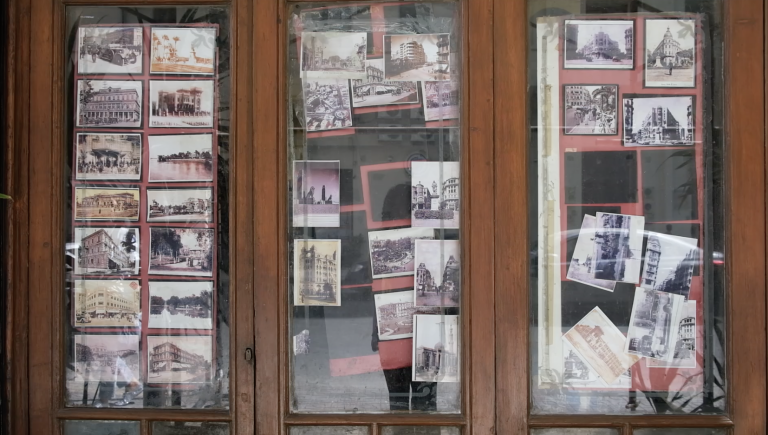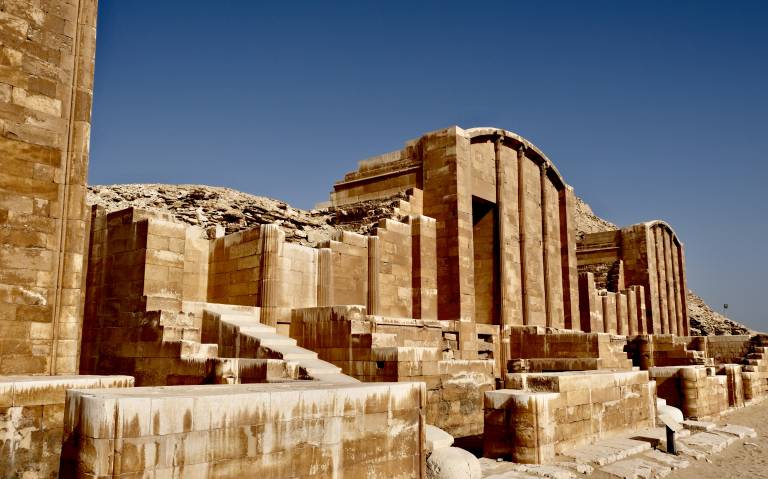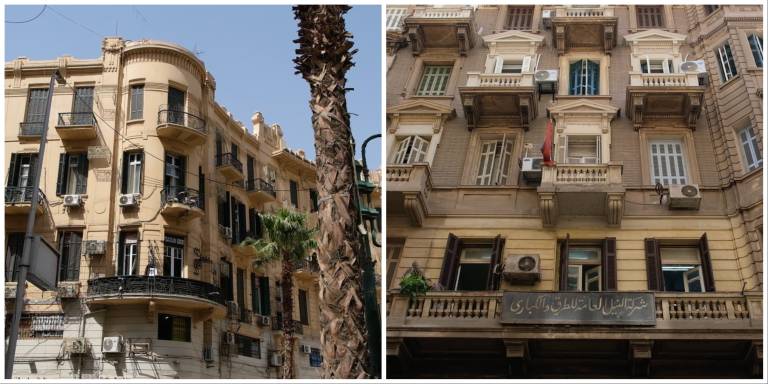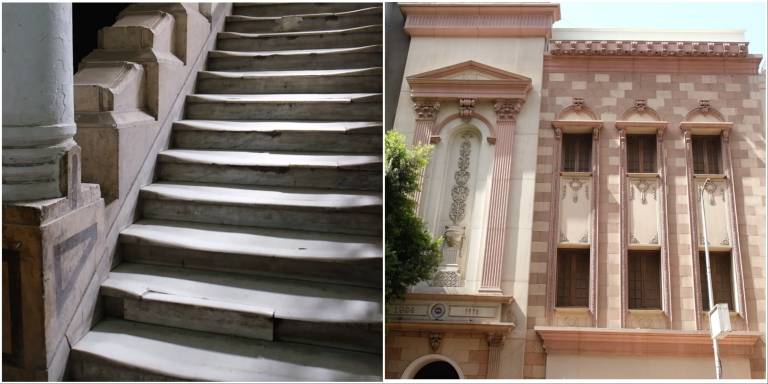Contemplating Modern Architectural History: Jamila Abdel-Razek in conversation with Jacob Paskins on modern architecture, empire and cross-cultural exchange

Jamila Abdel-Razek, 2023, photograph of Café Riche’s window, a landmark in downtown Cairo. The window displays photographs of Cairo’s modern architecture. The restaurant has become known for its position in important historical events, as a site for revolutionary activity in the 20th century and as a haven for Egyptian writers such as Naguib Mahfouz and beloved musicians like Umm Kulthum. The café was initially owned and frequented by Cairo’s foreign elite population, but eventually got placed into Egyptian hands, creating a new identity for the site that serves Carienes and holds their history.
How are modern cities produced? What does their architecture tell us? And how do we grapple with their histories? Something that I have never questioned until recently is the manner in which Cairo's downtown mimics Haussman’s model for Paris. Although we have become accustomed to walking through promenades, the Egyptian Museum being built in a neoclassical style and even driving along streets such as Champollion Rd, downtown has always felt Egyptian to me - the most nostalgic and worn with the memory of time despite its aggressive French influence.
It had me questioning how architectural planning acts as a site of experimentation, but also revelation. I became curious about the ways architecture is inhabited but also imposed by regimes of authority. Having taken a nosedive into the architectural history of ‘modern’ Cairo, I was confronted with a fascinating history of cross-cultural exchange that turns upside down typical notions of colonial power and empire. Exploring these histories and themes in a conversation with Dr. Jacob Paskins, lecturer and head of education in UCL’s History of Art department, architecture appears as “a living artefact that is not fixed in the moment where the building was completed, when the designs by the architect were afresh because in fact, we all essentially remake architecture every time we see it, whether that be a historical building that's still in use.”
In the questioning of architecture and its role in colonial regimes, I was fascinated by the unacknowledged elements of design. Buildings are mostly credited to the heroic status of the architect, which is what is written into history. However, Jacob considers the processes before architecture is complete, and especially focuses on construction labourers and the construction site. In considering and introducing a new narrative into what can be described as the West to East exchange, the role of construction workers can complicate such notions. In unearthing the relations between colonial powers such as France and their seminal position in North Africa, we can discover elements of cross-cultural exchange.
In considering the colonial relations between Algeria and France: “Through the 1950s and up until 1962, there is essentially, depending on the perspective, either a civil war or a war of independence between Algeria which was a French colony since the 1830s. This is an extremely distressing and violent and bloody conflict causing untold deaths and victims. And yet, there is a huge reliance on low paid labourers in factories, car factories, but also in construction sites in mainland France. And so we have a lot of economic migrants during this moment of conflict coming to work in France and in fact before 1962, Algerians are French nationals legally, it's essentially legally seen as internal migration. Because of the unfortunate colonial legacies and often very ugly racial power relations, all citizens of France are not treated equally…
“The conditions they found themselves at work and in terms of their living conditions were really terrible. Far worse conditions they may have felt in, say, rural Algeria, where there may have been great poverty. A lot of these workers found themselves living in really substandard housing in Paris. A whole series of economic problems come into focus on the building site.”
In the context of this untold narrative where Algerians played a seminal role in the production of constructing Parisien modern architecture, it is crucial to grapple with the relations/imaginations of the colonised and the coloniser. The legacies of West to East exchange becomes disrupted in many ways; in considering not only the hidden labour behind such monumental sites, but also the false conceptions of how the coloniser presents themselves to the colonised. Looking at what we can call an East to West exchange, I was interested in delving into France’s colonial and imperial involvement with Egypt and their role in the production of Egyptology as a discipline. I was curious about the ways that, although Paris was becoming a modern city, it was looking to elements of the past to construct such notions.
“There's a certain violent moment of the arrival of the French in North Africa, including Egypt, but also perhaps less acknowledged are that these are extraordinary urban civilizations, historical urban civilizations in particular, which might impact the shape of the European city in return. Let's not forget the Napoleonic invasions but also the influence of the obelisk as a motif. The mystique the French had of Egyptian civilization, I think, is evident in the 19th century with the placing of the obelisk in the centre of the Place de la Concorde.”
“Later, though, as more specialist archaeological knowledge is made in the early 20th century, in particular in Egypt, there's a huge fashion in Paris for all things Egyptian or supposedly Egyptian. There are modernist architects who are trying to find a new mode of expression often associated with Art Deco, sort of the 1920s and 30s, are describing their work as Egyptian, as very monumental, but less ornamental than Greek or Roman classicism. It's about those sort of bold forms of the obelisk, of the pyramid which actually has a very strong resonance with the idea of modernist architecture about trying to express pure forms. Monumentality through forms. The pyramids, the sphere, the cube - some modernists argued, were eternal forms. It was almost saying that the authentic modern culture was in ancient Egypt. Whether that was expressed intentionally at the time, I'm not so sure, but it's sort of in between the lines, they're trying to find a source for modernism that might even be ancient.”

Jamila Abdel-Razek, 2023, photograph taken at the Saqqara Necropolis in the Giza Governante. The ancient grounds once served as the Necropolis for ancient Egypt’s capital, Memphis.
These considerations and influences had me questioning what makes a city modern? What I find particularly interesting about the creation of Cairo as this cosmopolitan metropolis, a very global city, is that it’s modern architecture was imposed by Turkish rulers/viceroys in Egypt who sought to create an elite quarters, not for Egyptians, and not for themselves, but for the European foreign elite prior to the opening of the Suez Canal in 1869. I think it's really fascinating to see the ways in which the Ottoman empire has been largely ignored as this power in transmitting certain ideas.
From 1863 to 1879 Khedive Imail Pasha (Khedive being an honorific Persian title, but used to describe the Turkish Viceroys in Egypt) governed Egypt. Following his visit to the Universal Exhibition in Paris in 1867, he was eager to transform Cairo into what he described as ‘Paris along the Nile’. In mimicking Haussman’s model for Paris, he saw that Cairo’s downtown utilise and implement Haussminian city planning, Parisien rooflines, building in the style of Art Deco, beaux arts, belle époque, neoclassical, embellishing the buildings with arcades, balconies and pillars with carved stucco. Why was it the Ottoman empire that brought forth and imposed French influence within North Africa? And what does this say about the misconceptions we have about cross-cultural transmission?
“You've alluded to the Ottoman Empire, which is an ancient non-European empire and one that may have caused anxiety then say for French or British empires as we know now the way that global conflicts have happened in the 20th century. It's often been European powers trying to carve up older empires. But there has been more recent scholarship that has acknowledged the existence of those non-European influences and that has been very significant to show that these other lands, which have have been perhaps European colonies at times, have significant and active roles in their own histories, which have until recently been less acknowledged - certainly in the Western European perspectives. But a lot of scholars are now showing how important this idea of East - East relations is, which is a problematic term in itself because it's just mirroring the idea of the West and we really need to move beyond those dichotomies. But, the idea of the non-European and non-European encounter is crucial to our understanding of how history in this region has unfolded.”

Jamila Abdel-Razek, 2023, two photographic stills from a video I took visiting Cairo’s downtown. Both buildings are residential and hold a few offices.
Beyond the question of encounter and transmission, architecture in Cairo’s urban fabric arrived as an imposition. It stands as somewhat of a reminder of colonial rule, it does not immediately stand for something Egyptian. However, Jacob here describes how architecture must be dealt with under different circumstances.
“I think there's something about an urban space or a building that is different from the debates about statues recently. And the debates whether to tear them down or to resituate them, put them in a museum and contextualise them. And I think something about the portability of individual things like statues is different. It might be harder to justify retaining the presence of a very controversial figure if it could be relocated and recontextualized. But where do you draw the line in terms of a major building?”
In considering monumental architectural memory, I became drawn to the way many of these sites have now been reclaimed as something inherently Egyptian through the histories they have experienced since, or the ways that they are reused and inhabited now. One very poignant example is Tahrir Square, which translates into Liberation Square (and initially called Horreya square meaning freedom square), which has become a site of revolution and protest, especially during the 2011 Egyptian revolution for the resignation of the president at the time, Hosni Mubarak. The public square, commissioned by Khedive Ismail Pasha and produced by European architects, can be described as “a densely layered territory in which the modern meets the Mamluk, Haussmannian vistas meet cold-war brutalism, and networked paths meet the open agora”. As described in an article by Art Forum, “Throughout its modern history, Egypt has been mostly spoken for. Pashas, khedives, sultans, kings, colonial proconsuls, colonels, and generals have taken turns ruling it autocratically and ruthlessly”. This square looks at the ways in which, as Jacob describes, we can “reclaim and reappropriate spaces that historically may have been associated with colonial rule. Would that be the grand squares and vistas and boulevards or specific buildings themselves, whether they be governmental or other institutional buildings or mere buildings in a so-called European style. How they also continue to have a life. Those colonial narratives, which can actually be really positive in reforging new chapters. We've seen historical instances in many countries where buildings are set on fire and destroyed because of their association with a monarch or some tyrant. But should we really be especially in today's age of limited energy, resources and sustainability?”
Cairo’s downtown is now one of the few places in Cairo that feels Egyptian to me. It is one of the only areas of the city where people from all socio-economic positions live in the same vicinity - considering Cairo’s population have begun to move out of the city centre into satellite cities. These spaces have become sites of liberation. These buildings have become inhabited by Egyptians. They appear in black and white Egyptian films. They were frequented by beloved Egyptian writers and singers. “Should we actually be tearing down buildings just because of their histories? Or is there an opportunity to retain and reclaim this? It's not about rewriting history as the right wing media often likes to think. It's about remaking those histories and our new histories for the future.”

 Close
Close


